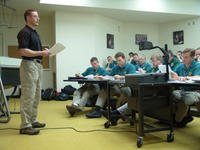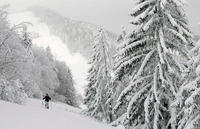-
New cloth captures noxious gasses, odors
Cornell university students develop a new cloth that can capture noxious gasses and odors — and that can be fashioned into masks or hooded shirts to be used by soldiers and first responders; the garments use metal organic framework molecules (MOFs) and cellulose fibers
-
-
Airports personnel don't report suspicions, mistrust technology
An in-depth study of the behavior of security personnel at European air terminals, finds that only 23.6 percent of airport employees and 58 percent of security workers said that they alerted others when they saw something suspicious — and that 54.3 percent of the workers and 40 percent of security personal never raised the alarm or called a security code; only 53.1 percent of airport employees and 63 percent of security workers said they put complete trust in security technologies
-
-
New material cleans water of radioactive contamination
NC State researchers develops material to remove radioactive contaminants from drinking water; the material is a combination of forest byproducts and crustacean shells; the new material not only absorbs water, but can actually extract contaminates, such as radioactive iodide, from the water itself; this material, which forms a solid foam, has applications beyond radioactive materials
-
-
Hi-tech goggles to reduce number of friendly fire incidents

The modern battle-field is saturated with autonomous, remotely controlled platforms and weapons, and everything moves very fast; in addition, many of the engagements take place in close quarters; all these increase the risk of friendly fire; DARPA wants a small New York company to develop augmented reality goggles which will tell soldiers on the ground which air assets are nearby, bearing which weapons, thus resulting in more accurate destruction of enemy assets, less risk to friendly forces, and fewer civilian deaths
-
-
Keeping water pure with detection nanosensors
Seven European countries, containing 35 percent of the European population, face a risk of water shortfall; University College Cork will coordinate a 3 million Euro EU project for the development of novel smart sensing materials for applications in water purification technology and clinical diagnostics
-
-
U.S. military robot to help detect radiation at Fukushima
The modified a military robot to navigate around Fukushima plant and produce a color-coded map of radiation levels; the robot includes a chemical, biological, radiological, nuclear, and explosive detection kit that can identify more than 7,500 environmental hazards, including toxic industrial chemicals and volatile gases; it also has temperature and air quality indicators and night vision, and it can sense sounds up to 1,000 meters away; the robot joins other pieces of specialized equipment, donated by QineticQ to help Japan deal with the crisis
-
-
Wastewater-treatment system to produce electricity
Scientists will bio-engineer bacteria to break down large amounts of solid waste using anaerobic digestion (without oxygen) in a reactor based on existing technology used by distilleries and pharmaceutical companies; they hope to be able to capture the gas from the process to generate electricity. Because the system would not produce other waste products, they also hope it could improve wastewater treatment in the developed world
-
-
Local Beaumont, CA officers attend special FBI training course

Officers from the local police department in Beaumont, California have been selected to attend a special law enforcement training course at the FBI Academy in Quantico, Virginia; located on a Marine base, the FBI Academy is highly selective, only choosing an estimated 1 percent of law enforcement officials in the United States to attend the special training; the ten week program consists of rigorous physical training as well as thorough lessons in the classroom; courses include Computer Environments for Law Enforcement, Investigative Interviewing, and Labor Law Issues for Law Enforcement Administrators; law enforcement officials train and live together in close quarters in an isolated, heavily wooded facility to help forge networks
-
-
Battery-less chemical detector developed
Conventional chemical detectors require an external power source, but Lawrence Livermore researchers have developed a nanosensor that relies on semiconductor nanowires rather than traditional batteries; the device overcomes the power requirement of traditional sensors and is simple, highly sensitive, and can detect various molecules quickly; its development could be the first step in making an easily deployable chemical sensor for the battlefield
-
-
Modeling shows limited spread of Fukushima's radioactive release in ocean
Daily computer simulations are suggesting that, so far, the hazardous radioactive materials being released into the sea by the Fukushima nuclear plants are still largely restricted to areas near the coast; the powerful Kuroshiro current — the Pacific’s version of the Gulf Stream — tends to block contaminated seawater from flowing southward toward Tokyo Bay while picking up little contamination itself
-
-
New device uses sniffer bees to detect explosives

The unassuming honeybees have a hidden talent — an even keener sense of smell than anyone first expected — which could make them one of the U.K.’s most ruthless and worst-feared weapons against terrorism; researchers developed a portable handheld sensor that holds thirty-six trained bees gently restrained in six cassettes inside the device; each is taught to recognize a particular odor and associate that smell with a food reward; the researchers have already trained their honeybees to detect a wide variety of explosive compounds and mixtures, including Semtex, C4, PE4, TNT, DMNB, gunpowder, and hydrogen peroxide
-
-
Ultra-sensitive sensor technology detects explosives, cancer
Princeton researchers have invented an extremely sensitive sensor that opens up new ways to detect a wide range of substances, from tell-tale signs of cancer to hidden explosives; the sensor, which is the most sensitive of its kind to date, relies on a completely new architecture and fabrication technique developed by the Princeton researchers; the device boosts faint signals generated by the scattering of laser light from a material placed on it, allowing the identification of various substances based on the color of light they reflect; the sample could be as small as a single molecule
-
-
OSU chemist developing solution to nerve agent exposure
Scientists are working to develop a new drug that will regenerate a critical enzyme in the human body that “ages” after a person is exposed to deadly chemical warfare agents; the drug will counter the effects of Tabun, VX, VR, Sarin, Soman, Cyclosarin, and Paraoxon, all of which take on a similar molecular structure upon aging
-
-
High School students build Florida police a robot
In Rockledge, Florida, the local police department just purchased a new remote controlled robot that is equipped with a video camera, night vision, a gas canister launcher; rather than spending hundreds of thousands of dollars to purchase the robot from a defense company, the Rockledge police department turned to local high school students; the robot can handle any terrain, launch grenades, and is strong enough to drag a person; it is also outfitted with a speaker and a microphone to enable two way communications in addition to a police throw phone that can be deployed during hostage negotiations; the robot cost $6,000 whereas similar professionally made robot would have cost more than $100,000
-
-
Heavy snows divert Colorado River water shortage, for now

This winter, heavy snowfall in Utah, Colorado, and Wyoming have helped to avert a water crisis along the Colorado River; after an eleven year drought in the region, residents have begun to worry about impending water shortages; the Colorado River supplies nearly thirty million people in seven states with drinking water as well as Mexico; the heavy snows could bring only a brief moment of respite; with demand exceeding supplies and with each year bringing less water, there is potential for a future disaster; if supplies continue to decline, water deliveries will be reduced when Lake Mead’s water level drops below 1,075 feet; as of 1 February, Lake Mead’s water level was at 1,091feet
-
More headlines
The long view
New Technology is Keeping the Skies Safe
DHS S&T Baggage, Cargo, and People Screening (BCP) Program develops state-of-the-art screening solutions to help secure airspace, communities, and borders
Factories First: Winning the Drone War Before It Starts
Wars are won by factories before they are won on the battlefield,Martin C. Feldmann writes, noting that the United States lacks the manufacturing depth for the coming drone age. Rectifying this situation “will take far more than procurement tweaks,” Feldmann writes. “It demands a national-level, wartime-scale industrial mobilization.”
How Artificial General Intelligence Could Affect the Rise and Fall of Nations
Visions for potential AGI futures: A new report from RAND aims to stimulate thinking among policymakers about possible impacts of the development of artificial general intelligence (AGI) on geopolitics and the world order.
Smaller Nuclear Reactors Spark Renewed Interest in a Once-Shunned Energy Source
In the past two years, half the states have taken action to promote nuclear power, from creating nuclear task forces to integrating nuclear into long-term energy plans.
Keeping the Lights on with Nuclear Waste: Radiochemistry Transforms Nuclear Waste into Strategic Materials
How UNLV radiochemistry is pioneering the future of energy in the Southwest by salvaging strategic materials from nuclear dumps –and making it safe.
Model Predicts Long-Term Effects of Nuclear Waste on Underground Disposal Systems
The simulations matched results from an underground lab experiment in Switzerland, suggesting modeling could be used to validate the safety of nuclear disposal sites.
